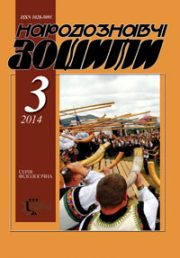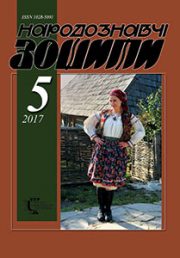The Ethnology Notebooks. 2021. # 1 (157), P. 131—141
УДК 745. 52(=161. 2):001. 891(083. 97)”XIX/XX”
DOI https://doi.org/10.15407/nz2021.01.131
Olha YAMBORKO
- ORCID ID: https://orcid.org/0000-0003-0340-5436
- Сandidate of Аrts (Ph. D),
- Associate Professor of Design and Art Theory
- Vasyl Stefanyk Precarpathian National University,
- Str. Sakharova, 34-a, 76014,Ivano-Frankivsk, Ukraine,
- e-mail: kalyna015@gmail.com
Introduction. Over the last thirty years, Ukrainian carpet weaving as an industry has lost its production infrastructure. Aesthetic priorities in interior design have changed, which has negatively affected the status of the Ukrainian carpet in the mass housing culture. These negative processes were offset by cultural, artistic and scientific activities.
Problem Statement. In the article we will try to analize the discourse of Ukrainian carpet weaving in scientific, practical and art programs of the late XX — early XXІ centuries. This is important for the promotion of Ukrainian carpet weaving as a cultural heritage at the national level and its incorporation into the world context.
Purpose. The object of the article is the discourse of Ukrainian carpet weaving in scientific programs, the subject is a presentation in book publishing, art and cultural studies and projects, museum collections and modern media resources, in art events; results of activity of specialized symposiums.
Methods. Historical and comparative research methods are used in the work.
Results. The panorama of activities, initiatives devoted to the Ukrainian carpet weaving for the last thirty years is recreated, the comparative analysis with world practices is carried out.
Conclusion. Over the last thirty years, Ukrainian carpet weaving as a branch has lost its production infrastructure, at the same time a certain dynamics of cultural, art and scientific development has been maintained here. This is reflected in a number of scientific papers, in book publishing, and especially programs aimed at restoring interest in carpet weaving. In this regard, it is worth mentioning the opening of the museum of carpet weaving in Hlynyany, which was preceded by the program «Revive Hlynyany carpet».
In general, most of the programs proved to be effective in terms of art practices, but never became a factor in the restoration of carpet production. This trend is not regional and is typical of other arts and crafts industries not only in Ukraine but also in countries with a post-Soviet past. An exceptional example, in particular in the field of carpet weaving, is demonstrated by the Azerbaijani experience.
To date, there are no specialized media resources dedicated to Ukrainian carpets, professional texts in the languages of international communication. Therefore, Ukrainian carpet weaving is not currently incorporated into the world context. The issue of developing the interactivity of Ukrainian museums is relevant.
The example of lizhnyks is indicative of the activities that took place in Ukraine during the 1990s and 2010s. Several diverse programs and projects were devoted to this subject. But today the industry has shrunk as much as possible, has problems with quality raw materials, the market, product certification ecc.
Keywords: subject of Ukrainian carpet weaving, art, culture, science, information resources.
REFERENCES
- Chehusova, Z. (2018). Ukrainian handmade carpet: historical past and prospects. Ukrainian art history:materials, research, reviews (Issue 18, pp. 111—122) [in Ukrainian].
- Knysh, B. (2019). Hutsul lizhnyks. Traditions and modern interpretations. The Ethnology notebooks, 1 (145), 81—90 [in Ukrainian].
- Padovska, O. (1994). Carpets of Podillya. The thesis for the academic degree of Doctor of Art History. Lviv [in Ukrainian].
- Kohut, H.V. (2003). Ukrainian «gentleman’s» carpets of the XVII—XVIII centuries: History and stylistics. The thesis for the academic degree of Doctor of Art History. Lviv [in Ukrainian].
- Dutka-Zhavoronkova,V. (2007). Carpets of Northern Bukovyna: traditions and innovation. The thesis for the academic degree of Doctor of Art History. Lviv [in Ukrainian].
- (1998).Ukrainian carpet: genesis, iconography, stylistics: materials intern. scientific-practical conf. Kyiv: State Museum of Ukrainian Folk Decorative Art [in Ukrainian].
- Shulha, Z. (Ed). (2001). Silk braid № 2: cat. of exib. Lviv: Liga-pres [in Ukrainian].
- Bokotej, M. (2018). The company «Galitske Glass»: the last outpost of Ukrainian folk music and lost hope. Bulletin of the Lviv National Academy of Arts(Issue 38, pp. 49—65) [in Ukrainian].
- Sezeva, N. (2012). Tyumen carpet. Tradition and modernity. Tyumen: Title [in Russian].
- Hanzha, P. (1996). Secrets of Ukrainian Handicrafts. Kyiv: Mystectvo [in Ukrainian].
- Zhuk, A. (1973). Ukrainian Soviet carpet.Kyiv: Naukova dumka [in Ukrainian].
- Zapasko, Ja. (1973). Ukrainian folk carpet weaving. Kyiv: Mystectvo [in Ukrainian].
- Nechyporenko, S. (2007). Ukrainian carpets. Kyiv [in Ukrainian].
- Skrypnyk, H.A., & Kara-Vasilieva, T.V. (Ed.). (2007—2016). History of Ukrainian decorative art: in 5 vol. Kyiv: IMFE MT Rylsky National Academy of Sciences of Ukraine [in Ukrainian].
- (2014). Flowers and birds in the design of Ukrainian carpets. Kyiv: Rodovid [in Ukrainian].
- (2018). Podillya carpet. Kyiv: Rodovid [in Ukrainian].
- (2019). Ukrainian carpet. Museum Collections Series (Issue 6). Vinnytsia: TVORY [in Ukrainian].
- (2018, 11 april). Responsible collecting. Retrieved from: https://medium.com/@yd.1347 (Last accessed:28.12.2020) [in Ukrainian].
- Radzievska,V. (2018, 16 april). «You can virtually try on any cut»: Eugene Dmitruk created the largest online atlas of folk clothing in Ukraine. Gazeta.ua. Retrieved from: https://gazeta. ua/articles/culture/_mozhna-virtualno-primiryati-na-sebe-budyakij-krij-evgen-dmitruk-stvoriv-najbilshij-v-ukrayini-onlajnatlas-narodnogo-odyagu/832093 (Last accessed: 28.12.2020) [in Ukrainian].
- Prychepiy, E., & Prychepiy, T. (2007). Embroidery of Eastern Podillya. Kyiv: RODOVID [in Ukrainian].
- Prychepiy, E., & Prychepiy, T. (2009). Embroidery of Eastern Podillya: Small series. Kyiv: RODOVID [in Ukrainian].
- Churylova, K. (2019, 4 march). Victor Yushchenko became the owner of the world’s largest collection of embroidered towels. Zaxid.net.Retrieved from: https://zaxid. net/viktor_yushhenko_stav_vlasnikom_naybilshoyi_u_sviti_kolektsiyi_vishivanih_rushnikiv (Last accessed: 28.12.2020) [in Ukrainian].
- National Museum of Folk Art of Hutsul and Pokuttya. Retrieved from: http://hutsul.museum (Last accessed:3.12.2020).
- National Museum of Ukrainian Folk Decorative Art. Retrieved from: http://www.mundm.kiev.ua/ (Last accessed: 3.12.2020).
- Siryj, R. (2018). Communications of archival data. Electronic resource for the presentation of material culture. Problems of preservation and promotion of cultural heritage: challenges and opportunities. II International scientific-practical conf. in the Museum of Folk. arch. and pob. in Lviv(Pp. 331—338). Lviv: Neo-Druk LLC [in Ukrainian].
- Azerbaijan National Carpet Museum. Retrieved from: https://azcarpetmuseum.az/ (Last accessed:10.11.2020).
- Antique Ottoman Rugs in Transylvania. Retrieved from: http://www. transylvanianrugs.com/ (Last accessed: 25.10.2020).
- Cite internationale de la tapisserie Aubusson. Retrieved from: www.cite-tapisserie.fr. (Last accessed:10.11.2020).
- Mykhailo Bilas: Virtual Museum. Retrieved from: http://www.bilas.art/ (Last accessed:15.11.2020).
- (2018, 9 november). Ukrainian Cultural Foundation on the verge of scandals. Retrieved from: http://prostir.museum/ua/post/ (Last accessed:15.11.2020) [in Ukrainian].
- Levadnyi, A. (2017).«Source spirituality», «The circle» as the two components of art the project «Art-textile». Bulletin of the Lviv National Academy of Arts(Issue 31, pp. 322—336) [in Ukrainian].
- Tkachuk, I., Kropelnytska, S., & Petrunyak, A. (2009). Cluster of folk arts and crafts «Suzirrya»: methods, commentary, advice. Ivano-Frankivsk: Tipovit [in Ukrainian].
- Losіuk, P. (Ed.). (2011). Colorfulwonder. Kosiv: Pysanyi kamin’ [in Ukrainian].
- Oleshchuk, I., & Shkribliak, M. (2018). Hutsul lizhnyk (woollen blanket): the discourse through the ages (scientific and expeditionary sketches). Chernivtsi: Druk Art [in Ukrainian].
- Melnichuk, A. (2015, 25 january). How to pick a sheep to the thread. Zbruc. Retrieved from: https://zbruc.eu/node/31932 (Last accessed:20.11.2020) [in Ukrainian].
- Humeniuk, V. (2019, 5 may). Obstacles to the revival of sheep in the Kosiv district. Hutsuliya. Retrieved from: https://huculia.info/hutsul-kosiv-sheep-breeding/ (Last accessed:20.11.2020) [in Ukrainian].






